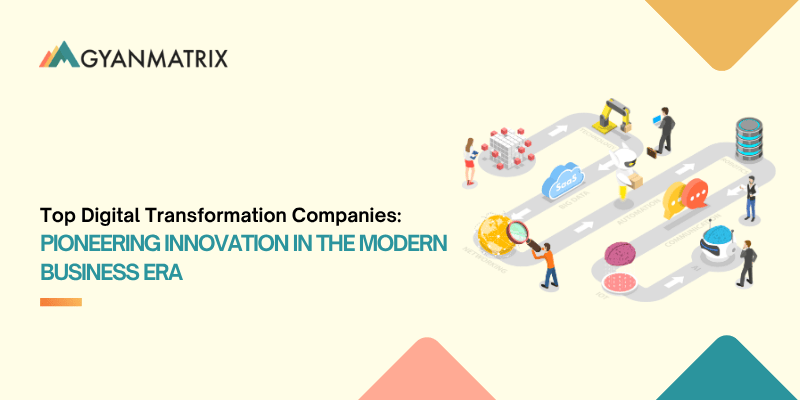How to Create a Successful Digital Transformation Strategy
The corporate environment is dynamic. Digital transformation is now essential for long-term success and a competitive edge. As the competition increases, they strive to grow, stand out, and ask for good strategies.
Companies are investing a lot in digital technologies. They want to improve consumer experiences. They also want to speed up processes and make new revenue sources. However, new technology alone is not enough to achieve a successful digital transformation. It requires a proper plan that fits the company’s main objectives.
Digital Transformation:
Digital transformation is about how digital tech is integrated into a business. It radically changes how the business runs and adds value for its clients. It means reconsidering standard corporate procedures and frameworks. This is to use digital tools and information. They improve productivity, creativity, and client satisfaction.
It provides a proper blueprint to implement certain changes in an organization. It also helps in tackling risks related to technological advancements.
Understanding Digital Transformation
-
What Is Digital Transformation?
Digital transformation isn’t just about using digital tech. It’s about using it in a business’s administration and operation. It’s about reimagining your business. Use the right digital tools and strategy. Use them to see exceptional growth.
To meet changing business needs, we must add digital technology. We will use it to create new processes. We will also use it to change existing company processes, culture, and consumer experiences.
This strategy includes:
- Implementing new tech
- Modernizing old systems
- Encouraging a digital-first mentality across the organization.
-
Key Components Of Digital Transformation
Technology:
This refers to cutting-edge instruments. They include cybersecurity, cloud computing, big data analytics, AI, and the Internet of Things (IoT). incorporating all these technologies and tools to manage the operations well. These tools facilitate process automation, data-driven insights, and enhanced decision-making.
Culture:
The values of a digital culture are adaptability. They include never-ending learning and a readiness to welcome change. Changing trends and allowing them to learn better and use it within the business. It calls for a mentality shift in which workers are motivated to try new things, work together, and be creative.
Operations:
Using digital tools to streamline processes can greatly increase productivity and efficiency. This means simplifying customer support. It also means improving supply chain management and automating repetitive jobs.
Benefits Of Digital Transformation For Businesses
Digitization has made the world small. It has let businesses expand easily. A good digital transformation company understands it well. They also reap its best rewards. Let’s enfold some of the crucial ones.
Enhanced Efficiency:
Automating repetitive tasks makes processes faster. It also reduces errors by cutting the amount of manual work needed. Also, it allowed standardization in the operations, which will result in fewer problems and flaws in the work. Using a successful digital transformation strategy provides efficiency and ease of work.
Improved Decision-Making:
Businesses may make well-informed decisions. They can do this by using the actionable insights from advanced analytics. It can get accurate and appropriate results, which can help them transform and work better.
Improved Customer Experience:
Personalized customer interactions made possible by digital tools increase client happiness and loyalty. They can know about the exclusives and personalized choices. They can provide changed and custom solutions.
Setting Clear Objectives
The first step in a digital transformation strategy is to find clear, reachable goals. These goals should fit your company’s objectives. You can get the help of a well-experienced digital transformation consultant, who can help you achieve your objectives. These goals must be: time-bound, doable, relevant, measurable, and targeted. They must be SMART: Smart, Measurable, Attainable, Relevant, and Timely.
-
Aligning Digital Transformation with Business Strategy:
Digital transformation needs to be incorporated into a larger business plan rather than happening in a vacuum. This link ensures that digital projects have measurable results. They also fit with the company’s main goals. When it is used in a parallel way, it will be easier to achieve the goals.
Regularly assess and update the strategy. Do this in response to changing business requirements and advances in technology.
Building a Strong Leadership Team
Good plans and objectives need strong mindsets. They also need hardworking workers.
-
Forming a Cross-Functional Digital Transformation Team
Digital transformation is effective. It needs a committed team. The team must have a range of expertise and viewpoints. The team should include people from many departments. These include operations, marketing, and finance. It should also include a digital transformation consultant and an IT professional.
Strong leadership is crucial. It is needed to align the organization, overcome resistance, and drive the transition.
Fostering a Digital Culture
We must create an environment that supports digitization. It must be used in daily work to make accessing the tools easy.
-
Encouraging Collaboration and Communication
Creating a digital-first culture means fostering an atmosphere that values cooperation and communication. This way, communication and cooperation will be strong among the workforce.
Make sure all staff are in the process. They should have access to digital tools. The tools will help them work together. Offering training can help staff gain needed digital skills. It also keeps them current with new trends.
Investing In The Right Technology
You need to do proper research to know about the technological updates and use the right technology for your company.
-
Evaluating And Selecting Technology Vendors
Your digital transformation will not be successful unless you select the appropriate technology. Consider if a vendor fits your goals. Also, look at their ability to scale, security features, and support services. Do this when evaluating potential technology partners.
Reach out to a reliable platform for technological assistance. Including stakeholders in decisions is important. It ensures the strategies align with their goals.
Conclusion
They can use futuristic techniques and tools. They can do this with hardworking employees. It will help them transform and reach greater heights. With strong leadership and setting attainable objectives, the goals can be easily achieved. The future will be all about digital transformation. It’s becoming a necessity in today’s fast world.
SaaS Development Company in India: Why India Leads the Global SaaS Innovation Curve
SaaS Development Company in India: Why India Leads the Global SaaS Innovation Curve The ...
Top Digital Transformation Companies: Pioneering Innovation in the Modern Business Era
In an era where technology underpins every facet of business, digital transformation is no ...
7 Strategic Reasons Why GCC India Is the Silent Engine Behind Tech Giants’ Growth
Global Capability Centers in India have quietly transformed into innovation powerhouses, playing a pivotal ...
Global Capability Center India: Strategic Growth Engine for Global Enterprises
Executive Summary Global Capability Center India is evolving far beyond traditional offshore service models into ...
Unleashing Blockchain development: Driving Business Efficiency and Innovation
Blockchain Development is no longer just a buzzword—it’s a game-changer for businesses across industries.From enhancing ...
Scale Your Business Through GyanMatrix – Your Trusted Partner for Global Growth
In today’s rapidly evolving business landscape, scaling your company efficiently while managing costs and maintaining ...








